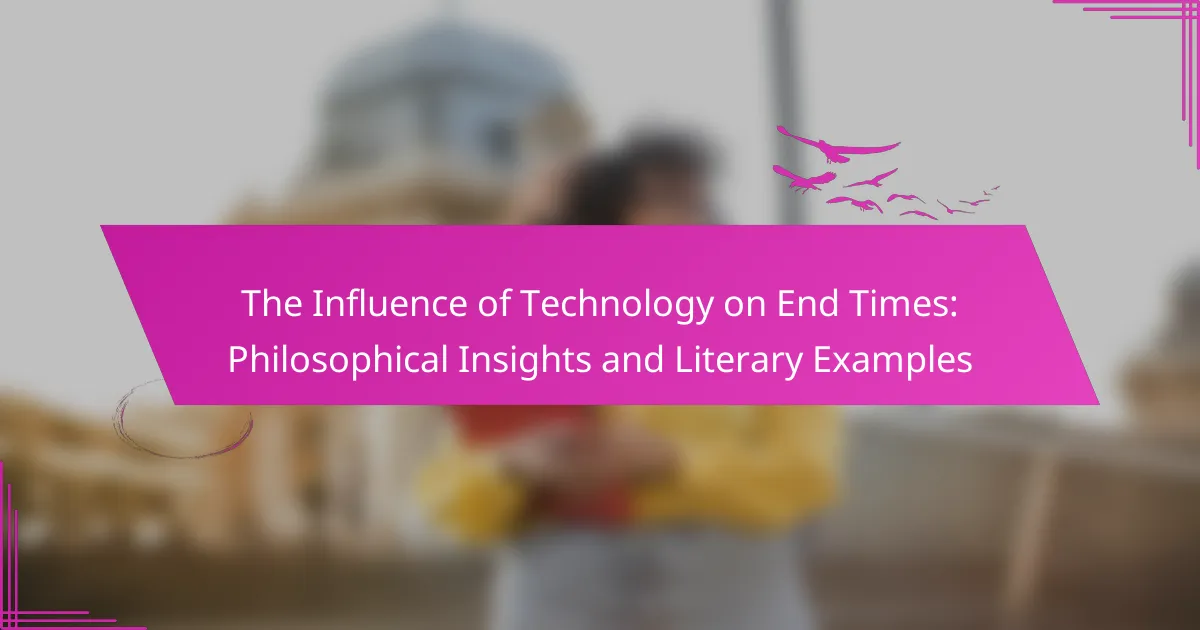Technology profoundly shapes contemporary views on apocalyptic scenarios, influencing both philosophical insights and literary narratives. It accelerates the spread of dystopian themes, reflecting societal fears about climate change and artificial intelligence. Authors like Margaret Atwood and Cormac McCarthy illustrate the intertwining of technology with survival and moral dilemmas. Ethical considerations and the potential for societal collapse further highlight the complexities of technology in the context of end times.
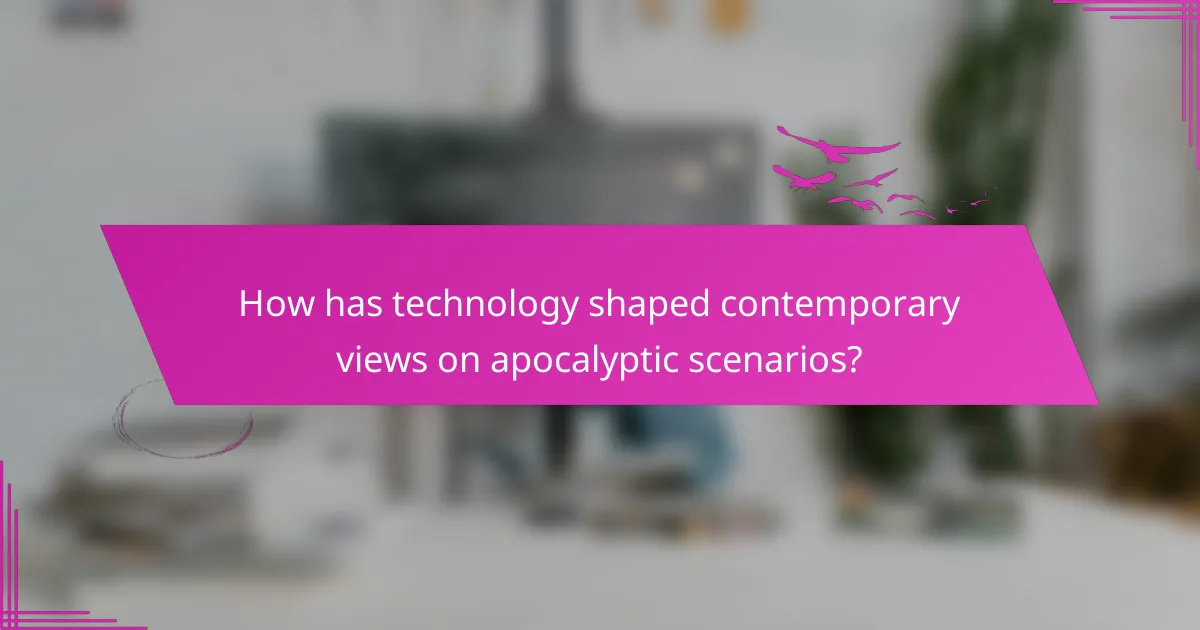
How has technology shaped contemporary views on apocalyptic scenarios?
Technology has significantly influenced contemporary views on apocalyptic scenarios by shaping perceptions and narratives. The rise of digital media and advanced communication tools has enabled the rapid dissemination of apocalyptic themes in literature and philosophy. For instance, dystopian novels often reflect societal fears exacerbated by technological advancements, such as climate change and artificial intelligence.
Moreover, technology fosters a sense of immediacy regarding potential disasters, as news spreads quickly through social platforms. This immediacy can heighten anxiety about end times, influencing public discourse. Philosophers also explore how technology alters human experience and existential threats, prompting deeper reflections on humanity’s future.
In literary examples, authors like Margaret Atwood and Cormac McCarthy illustrate how technology intertwines with human survival and moral dilemmas in apocalyptic settings. These narratives often serve as cautionary tales, urging society to consider the consequences of unchecked technological progress.
Thus, technology not only shapes the content of apocalyptic scenarios but also impacts the collective consciousness surrounding them, making these themes more relevant in contemporary discussions.
What philosophical frameworks inform our understanding of technology and the end times?
Philosophical frameworks such as existentialism and posthumanism shape our understanding of technology and the end times. Existentialism emphasizes individual choice and meaning in a technologically driven world, while posthumanism explores the implications of merging humanity with technology. Both perspectives highlight concerns about identity, morality, and the future of human existence in the face of rapid technological advancement. Literary examples, like Mary Shelley’s “Frankenstein” and Don DeLillo’s “White Noise,” illustrate these themes, showcasing the tension between human values and technological progress.
Which literary works explore the intersection of technology and apocalyptic themes?
Literary works that explore the intersection of technology and apocalyptic themes include “Neuromancer” by William Gibson and “Snow Crash” by Neal Stephenson. These narratives depict how technological advancements can lead to societal collapse.
In “The Road” by Cormac McCarthy, technology’s failure results in a post-apocalyptic world, emphasizing human survival. Similarly, “I Am Legend” by Richard Matheson examines the consequences of scientific experimentation gone wrong, showcasing technology’s role in creating apocalyptic scenarios.
These works illustrate the philosophical insights regarding humanity’s reliance on technology and the potential for catastrophic outcomes. They provoke reflection on ethical considerations surrounding technological progress.
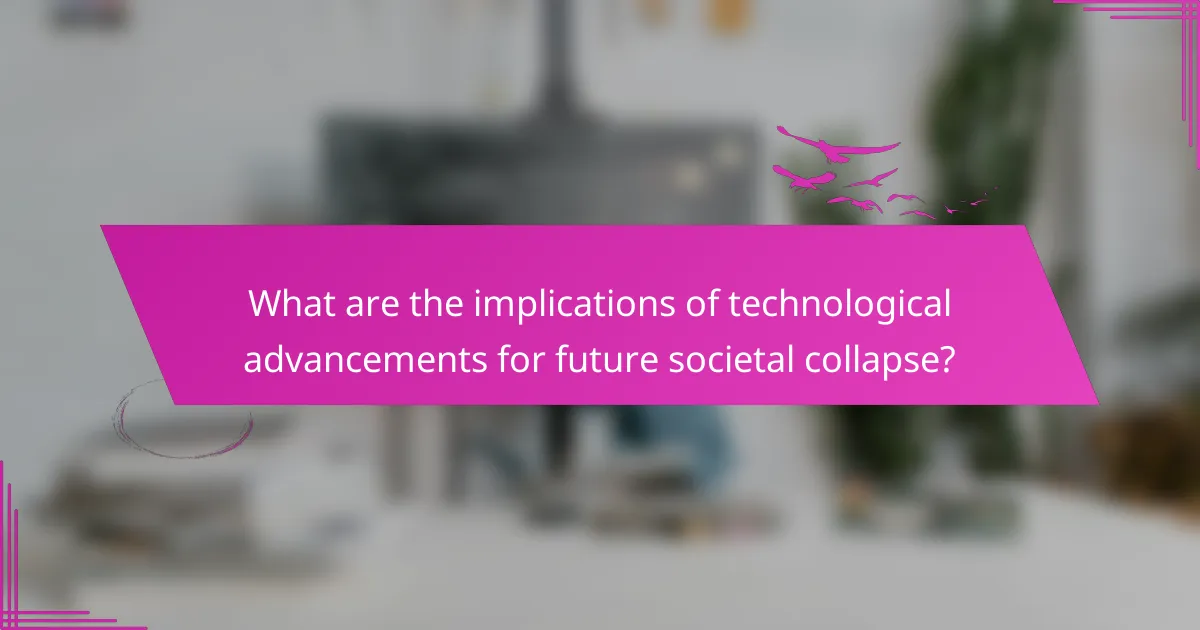
What are the implications of technological advancements for future societal collapse?
Technological advancements can lead to societal collapse by exacerbating inequality, fostering dependency, and creating existential risks. Innovations like artificial intelligence and biotechnology may outpace ethical considerations, leading to unintended consequences. The reliance on technology can weaken social structures, as seen in dystopian literature. As a result, these factors combine to pose significant threats to societal stability and cohesion.
How do different cultures perceive technological impacts on doomsday predictions?
Different cultures view technological impacts on doomsday predictions through various philosophical and literary lenses. For example, Western cultures often associate technology with apocalyptic scenarios, reflecting fears of nuclear war or climate change. In contrast, Eastern philosophies may emphasize harmony with nature, suggesting technology can be a tool for balance rather than destruction.
Literary examples, such as “Fahrenheit 451” by Ray Bradbury, illustrate these cultural perceptions, showcasing technology’s role in societal decay. Conversely, works like “I, Robot” by Isaac Asimov explore technology’s potential to avert disaster through ethical frameworks.
Overall, cultural context shapes how technology influences beliefs about the end times, highlighting a spectrum from fear to hope.
What role does artificial intelligence play in shaping end time narratives?
Artificial intelligence significantly shapes end time narratives by influencing perceptions and interpretations. It enhances storytelling through data analysis, creating more relatable scenarios. AI-driven simulations present potential futures, making philosophical discussions more tangible. Literary examples often reflect AI’s role in exploring existential themes, emphasizing human dependence on technology.
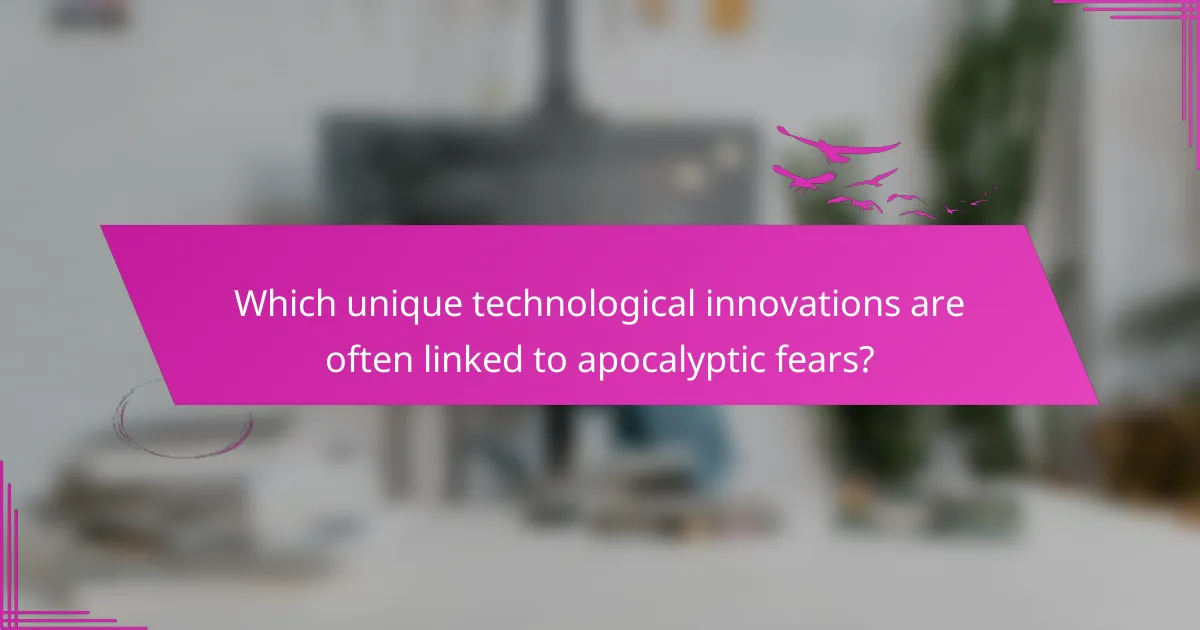
Which unique technological innovations are often linked to apocalyptic fears?
Technological innovations often linked to apocalyptic fears include artificial intelligence, biotechnology, nuclear weapons, and climate engineering. These advancements raise concerns about loss of control, ethical dilemmas, and potential catastrophic consequences. For instance, AI’s potential to surpass human intelligence evokes fears of unintended outcomes. Biotechnology, particularly gene editing, prompts worries about designer organisms and ecological disruption. Nuclear weapons symbolize existential threats, while climate engineering presents risks of unforeseen climatic shifts. Each innovation reflects unique attributes that amplify societal anxieties about the future.
How do social media platforms influence perceptions of impending doom?
Social media platforms significantly shape perceptions of impending doom through the amplification of fear-based narratives. These platforms facilitate rapid dissemination of information, often prioritising sensational content that evokes strong emotional responses. As a result, users may develop heightened anxiety regarding global crises, such as climate change or pandemics.
The unique attribute of social media is its ability to create echo chambers, where like-minded individuals reinforce each other’s fears. This can lead to a distorted view of reality, making threats seem more imminent than they are. Additionally, algorithms prioritise engagement, often favouring alarming news over balanced reporting, further skewing public perception.
Research indicates that repeated exposure to doom-laden content can desensitise users, leading to apathy or fatalism. This rare attribute of emotional fatigue can diminish proactive responses to genuine threats. Ultimately, the influence of social media on perceptions of doom reflects a complex interplay between technology, psychology, and societal narratives.
What are the psychological effects of technology-induced anxiety regarding the end times?
Technology-induced anxiety regarding the end times can lead to heightened stress, paranoia, and existential dread. This anxiety often stems from constant exposure to alarming news and apocalyptic narratives amplified by digital media. As a result, individuals may experience a distorted perception of reality, impacting mental health and social interactions. The unique attribute of this phenomenon is its connection to the rapid dissemination of information, which can overwhelm individuals, creating a sense of urgency and helplessness.
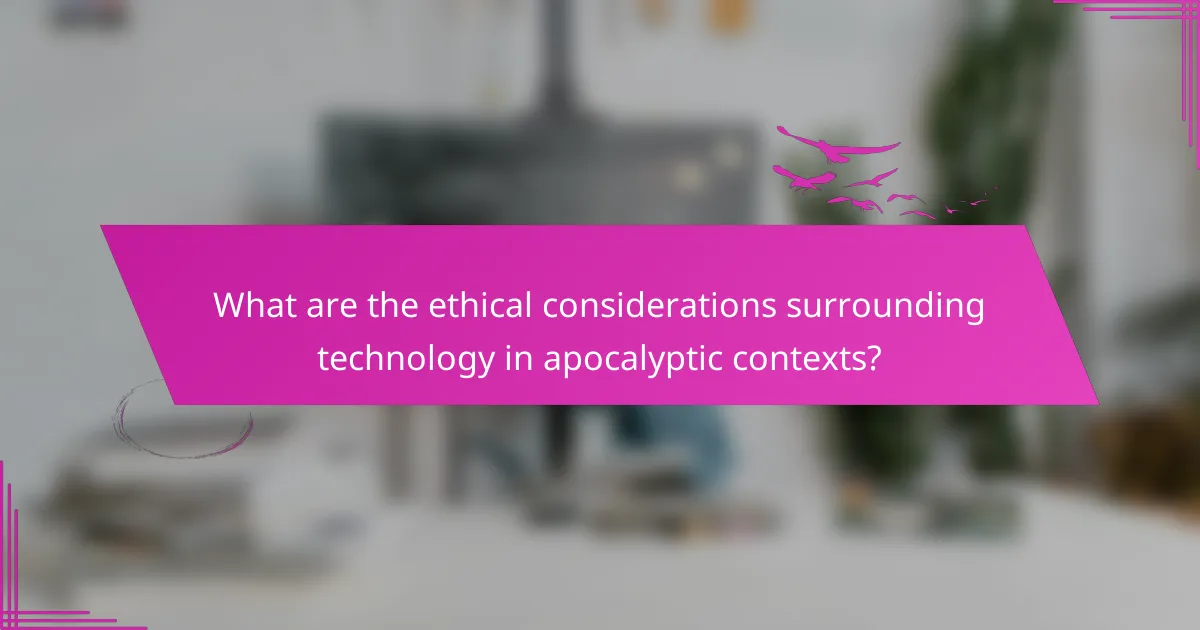
What are the ethical considerations surrounding technology in apocalyptic contexts?
Ethical considerations surrounding technology in apocalyptic contexts include the potential for misuse, the impact on human dignity, and the consequences of surveillance. Technology can exacerbate social inequalities and lead to moral dilemmas in resource allocation. For example, advanced weaponry may be deployed without ethical constraints, raising concerns about accountability. Additionally, reliance on technology can diminish human agency, prompting philosophical debates on autonomy and responsibility. These issues highlight the need for ethical frameworks to guide technological development in crisis scenarios.
How do technological disparities affect global responses to potential crises?
Technological disparities significantly hinder global responses to potential crises by creating unequal access to resources and information. Regions with advanced technology can mobilise quickly, while those lacking it face delays in communication and response efforts. For example, during natural disasters, countries with robust digital infrastructure can coordinate rescue operations more effectively than those without. This disparity can lead to increased casualties and prolonged recovery times in less technologically equipped areas. Furthermore, the philosophical implications of these disparities highlight ethical considerations regarding equity and justice in crisis management.
What lessons can be drawn from past technological failures during critical events?
Technological failures during critical events reveal significant lessons about reliance and preparedness. One key lesson is the importance of robust infrastructure. For instance, the Y2K scare highlighted vulnerabilities in legacy systems. Another lesson is the need for comprehensive testing; failures in emergency communication systems during natural disasters exposed gaps in readiness. Additionally, these failures emphasise the necessity of adaptability; technology must evolve alongside emerging threats. Lastly, ethical considerations in technology deployment must be prioritised to prevent misuse during crises.
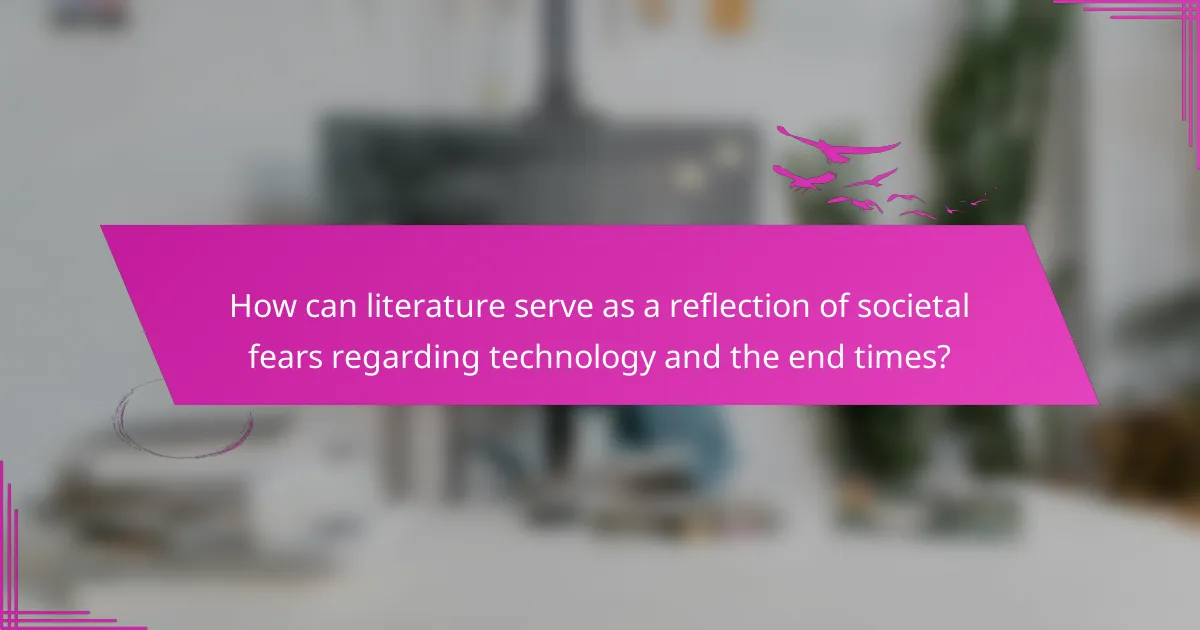
How can literature serve as a reflection of societal fears regarding technology and the end times?
Literature reflects societal fears regarding technology and the end times by exploring themes of dystopia and existential crisis. Many authors use technological advancements as metaphors for impending doom, illustrating anxieties about loss of humanity and control. For instance, works like George Orwell’s “1984” and Aldous Huxley’s “Brave New World” depict societies where technology exacerbates oppression and alienation. These narratives serve as cautionary tales, warning against unchecked technological progress. As a result, literature becomes a vital medium for examining the moral implications of technology and its potential to shape human destiny.
Which authors have notably contributed to the discourse on technology and apocalypse?
Prominent authors contributing to the discourse on technology and apocalypse include Neil Postman, Marshall McLuhan, and Don DeLillo. Their works explore how technology shapes societal perceptions of impending doom.
Neil Postman’s “Amusing Ourselves to Death” critiques television’s impact on public discourse, suggesting it leads to a dystopian future. Marshall McLuhan’s “The Medium is the Massage” examines how media technology alters human experience and consciousness, hinting at apocalyptic consequences. Don DeLillo’s “White Noise” reflects on technology’s pervasive role in modern life and its potential to create existential anxiety.
These authors provide philosophical insights that deepen understanding of the relationship between technology and apocalyptic narratives. Their unique perspectives highlight the cultural and psychological implications of living in a technologically saturated world.
What narrative techniques are commonly used to depict technological end times?
Common narrative techniques used to depict technological end times include dystopian settings, unreliable narrators, and fragmented timelines. These techniques create a sense of disorientation and urgency, reflecting societal anxieties about technology’s impact. Dystopian settings often illustrate a world where technology has led to societal collapse, evoking fear and caution. Unreliable narrators can challenge readers’ perceptions, highlighting the ambiguity of truth in a technologically driven society. Fragmented timelines enhance tension, emphasizing the chaotic nature of existence in a world dominated by technology.
What practical strategies can be employed to mitigate technology-related anxieties about the future?
To mitigate technology-related anxieties about the future, individuals can adopt practical strategies. Engaging in critical thinking about technological advancements helps in assessing their implications. Practicing mindfulness reduces stress by fostering present-moment awareness. Building community connections provides support and shared perspectives on technology’s role. Setting boundaries around technology use can prevent overwhelm. Educating oneself about technology promotes informed decision-making and reduces fear. Lastly, focusing on positive technological narratives can inspire hope and resilience.
